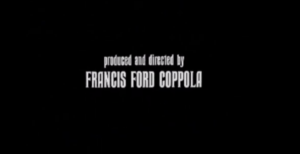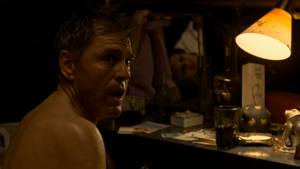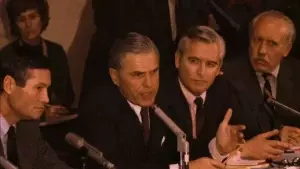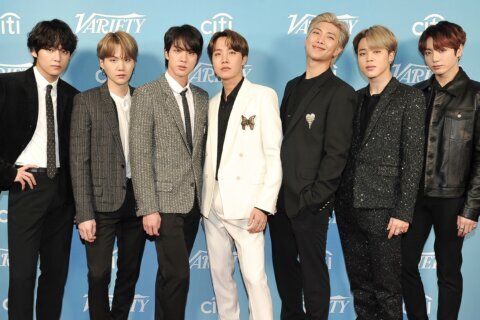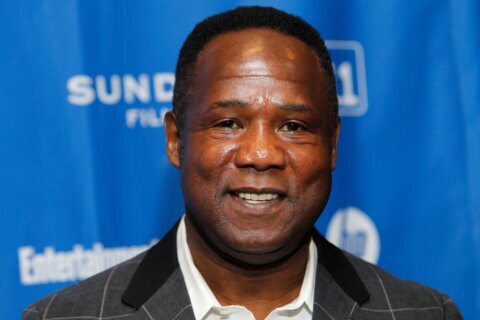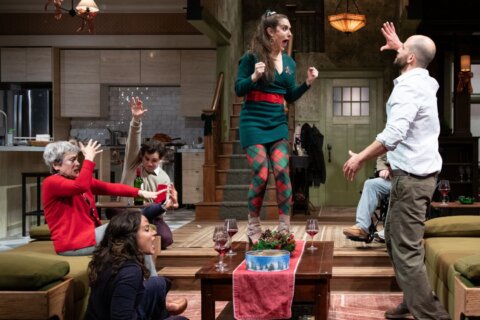In today’s moviegoing climate, can you imagine a film that’s both mainstream enough to be the year’s top-grossing blockbuster and artistic enough to win the Oscar for Best Picture?
That’s “The Godfather,” which returns to AMC Theatres starting this Friday to celebrate its 50th anniversary with a 4K Dolby restoration of Francis Ford Coppola’s 1972 masterpiece.
The franchise remains the only original and sequel to both win Best Picture. As a combined piece of work, it may be the greatest filmmaking we’ve ever seen. So, what exactly makes “The Godfather” the perfect marriage of rollercoaster ride and symbolic art?
It’s easy to understand its blockbuster appeal with actors like Brando, Pacino, Caan, Duvall and DeNiro spitting lines like, “I’m gonna make him an offer he can’t refuse,” “It’s not personal, it’s strictly business,” “Leave the gun, take the cannoli,” “Keep your friends close but your enemies closer,” and “Just when I thought I was out, they pull me back in.”
However, the artistic merits are more abstract, a blissful combination of Nino Rota’s operatic music, Gordon Willis’ shadowy cinematography and Coppola’s masterful direction, which I’d love to explore with you now as we revisit the magnum opus in theaters today.
Here are 10 deeper layers of “The Godfather” that I’ve found over the years:
(Screenshots courtesy of YouTube)
1. The Puppetmaster
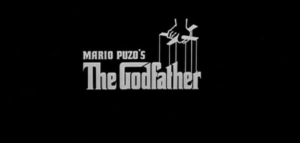
Our analysis begins right at the opening credits with a marionette logo signaling the film’s theme of men seeking positions of power to hold all the strings. As Don Vito Corleone tells his son Michael, “I refused to be a fool, dancing on the string held by all those big shots … but I thought that when it was your time that you would be the one to hold the strings.”
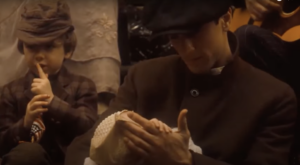
The marionette imagery reappears in “Part 2” as Young Vito holds Baby Michael on their stoop in Little Italy, waving his infant son’s hand like a puppet. Vito similarly holds Young Michael’s hand to wave goodbye on a moving train in the haunting final memory of Part 2.
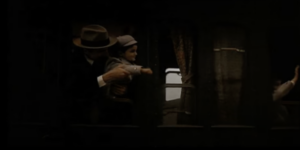
2. Sleeps with the Fishes
The line “sleeps with the fishes” has become part of the gangster lexicon just like “going to the mattresses” means an all-out gang war. It was popularized in Part 1 by Tessio’s legendary quote, “Luca Brasi sleeps with the fishes,” as the Corleone family receives a “Sicilian message” of a dead fish wrapped in Luca Brasi’s bloody bulletproof vest.
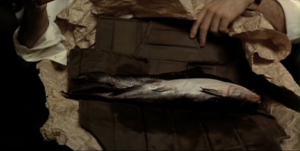
However, did you know that Coppola foreshadows Luca Brasi’s fishy demise? As Brasi enters the very bar where Sollozzo will have him stabbed through the hand and choked to death, Coppola films the scene through a fish pattern on the window! This is next-level filmmaking as the director drops visual clues that we can devour on repeat viewings.
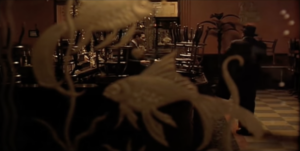
3. Dangerous Oranges
Coppola also foreshadows danger with oranges. At the wedding, Tessio crosses Mama Corleone to grab an orange, symbolizing that he will die as a result of crossing the family.
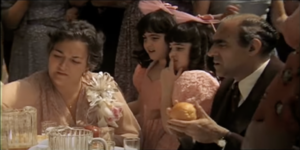
More overtly, Vito spills a basket of oranges in the street while running away from a pair of gunmen in a shocking attack. Thankfully, he survives for a Hitchcockian hospital scene.
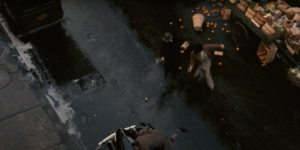
When Vito later dies of a heart attack in the garden, he stuffs orange peels inside his lips to pretend to be a monster with his grandson, who “shoots” him, not understanding the severity of what just happened. It’s one of the most heartbreaking scenes ever filmed.
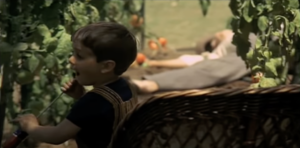
The dangerous oranges continue in Part 2. In the 1950s storyline, Michael is skeptical of Johnny Ola’s initial gift of an orange from Hyman Roth in Miami. In the 1920s flashback storyline, the villain Fanucci picks up an orange right before he’s killed by Young Vito.
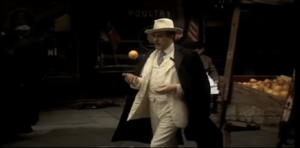
4. The American Dream Corrupted
At its core, “The Godfather” is a cautionary tale of the American Dream. On the positive side, Coppola insists that anyone can make it in the land of opportunity as Young Vito arrives as an immigrant on Ellis Island, staring at the Statue of Liberty with possibility.
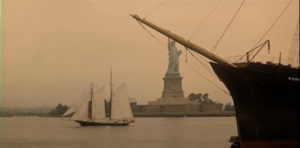
However, the greedy quest for power ultimately corrupts. As an adult, Vito presides over a gangster empire that whacks people in front of the same Statue of Liberty in the background of the Meadowlands. It’s fitting that the statue now appears smaller in the distance, suggesting freedom is a responsibility that is too often squandered and exploited.
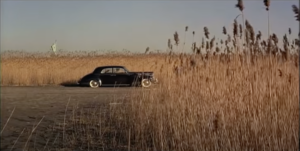
5. Everything is Corruptible
In pursuit of the American Dream, the master manipulators know how to influence every sector of society, including law enforcement. Capt. McCluskey’s half-lit face paints him as “a crooked cop who got mixed up in the rackets.” As Michael says, “We got people in the newspapers, right? They might like a story like that.” By the end, Michael is half-lit, too.
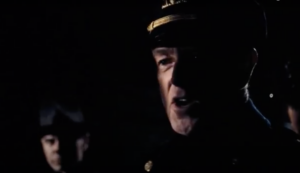
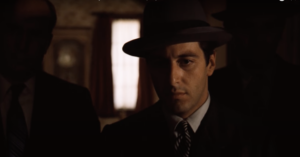
Showbiz is also corruptible. The horse-head-in-the-bed scene shows Vito intimidating a Hollywood producer (Oscar statue on his nightstand) into casting his godson. Favors are indeed threats: “My father assured him that either his brains or his signature would be on the contract.” Cue the “thank you” bouquet from Johnny Fontane (i.e. Frank Sinatra).
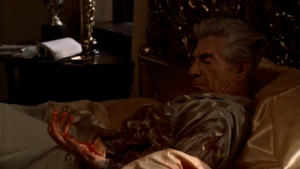
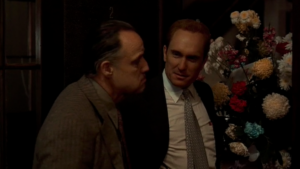
Most corruptible are the politicians. In Part 1, Sollozo tells Vito, “I need all of those politicians that you carry around in your pocket, like so many nickels and dimes.” Kay mocks the idea, “Do you know how naive you sound, Michael? Presidents and senators don’t have men killed!” Michael delivers a cold reply, “Oh? Who’s being naive, Kay?”
This theme is continued in Part 2 in the character of Sen. Geary, who initially threatens Michael by turning a toy cannon toward him at his desk. Michael gets the last laugh, killing his prostitute (who appears in the mirror behind him) to acquire dirt on the senator. Later, the senator shows up on the very Congressional committee that acquits Michael.
6. Religious Hypocrisy
If the police, showbiz, politicians and courts can be corrupted, so can the church. Religious hypocrisy is epitomized in the famous baptism sequence, intercutting Michael’s church prayers with images of his henchmen whacking the rival heads of the five families. “Do you renounce Satan?” Gun blast. “I do renounce him.” He becomes a Godfather in two ways.
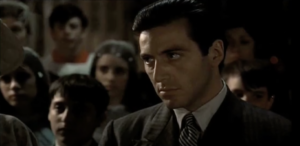
Part 2 features my favorite example as Coppola shows a religious parade in Little Italy. As his camera tracks from left to right beside a Christ madonna covered in dollar bills, notice how the street vendor stands first block the money (showing just Christ), then block Christ (showing just the money). Coppola takes his critique all the way to the Vatican in Part 3.
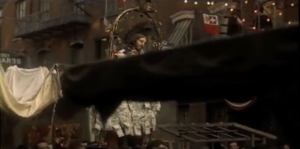
7. Dividing the Cake
Once you’ve taken over your own country, you might as well expand your empire to take over the world. In Part 2, Hyman Roth celebrates his birthday with a rooftop gathering in Havana where he carves a cake with a picture of Cuba, while he figuratively divvies up his empire. It’s a direct parallel to the Cosa Nostra meeting to hand out golden telephones.
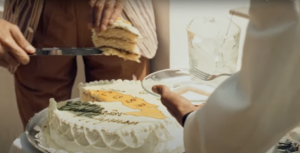
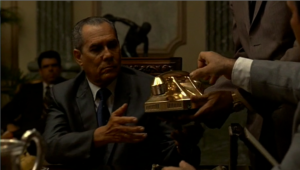
However, Michael issues a warning after seeing an insurgent’s suicide bombing: “Soldiers are paid to fight; the rebels aren’t. It means they could win.” This sets up Castro ousting Batista on New Year’s Eve where fireworks and champagne corks drown out gunshots as Michael acknowledges Fredo’s betrayal with a Judas-style kiss: “I know it was you, Fredo.”
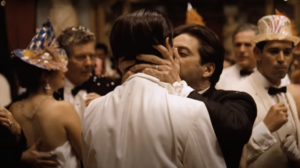
8. Fredo’s Bad Omen
After Fredo’s betrayal, Michael confronts him at their Lake Tahoe estate. Michael sits upright, symbolically looking down on Fredo, who pathetically sprawls out. Notice how a row of snow-covered tires resemble life rafts on the dock behind Michael, while there are none behind Fredo, visually dooming him to die in the very water behind them.
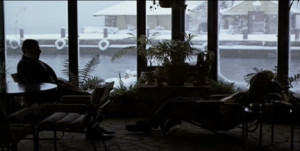
We get the exact reverse shot from outside the glass looking in when Michael orders Fredo to be whacked in a fishing boat mid-prayer: “Hail Mary, full of grace, pray for us sinners.” After the gun blast, Michael simply lowers his head as seagulls cry out to the heavens.
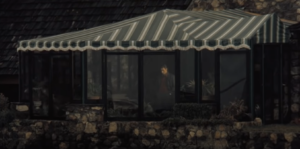
9. Sons vs. Fathers
Michael killing his brother is the ultimate sin, showing just how unlike his father he has become. While Vito ran a criminal empire, he maintained a certain moral code valuing family above all. When he finds out Michael committed his first murder, Vito looks disappointed in the hospital. He later tells him in the garden: “I never wanted this for you.”
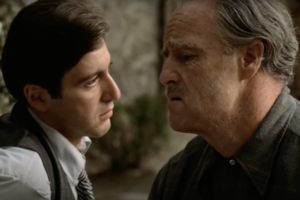
As Mario Puzo wrote for Brando in “Superman” (1978): “The son becomes the father, and the father, the son.” Thus, Part 2 features brilliant transitions between the parallel storylines of Michael (Al Pacino) and Vito (Robert DeNiro) when they were both roughly the same age. Dissolves show the two legends’ faces on screen at the same time.
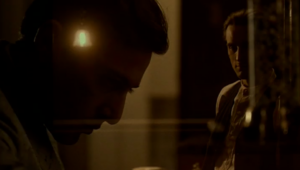
At one point, Pacino’s face dissolves directly into DeNiro’s face, both gesturing toward their mouths with concern over the health of their children (miscarriage vs. pneumonia).
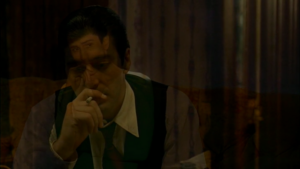
Vito once said, “A man who doesn’t spend time with his family can never be a real man,” but Michael forsakes his family entirely. In a brilliant shot, Coppola shows Michael’s desk in the foreground to symbolize his workaholic nature. Michael appears through the glass next to a toy car that his henchmen bought as a gift for his son. It’s now buried in snow.
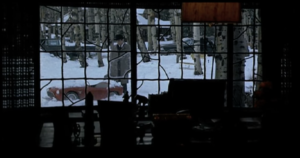
In Part 1, Vito’s desk was always surrounded by family. During a flashback in Part 2, Vito’s desk sits in the background as Sonny’s kids tragically say, “Daddy’s fighting again!” After an argument over his war deferment, Michael sits abandoned at the dinner table as his family cheers Vito off screen, “For he’s a jolly good fellow!” Michael knows no such joy.
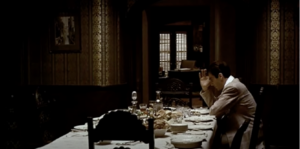
10. Behind Closed Doors
This same doorframe is used as Coppola warns against toxic masculinity with a motif of men shutting doors on women. After Michael lies to Kay in the final scene, Coppola subverts the “male gaze” by showing Kay’s female perspective watching henchmen “kiss the ring.” As the door closes, Coppola cuts back to see the door wipe across her face.
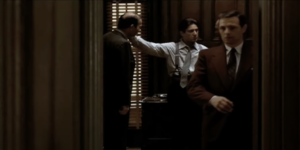
It’s inherited behavior, as Young Vito closes a door on his wife in Part 2 to inspect guns handed to him through a window by Young Clemenza, which he inspects in a bathtub. (Clemenza’s bathtub suicide would have been a killer parallel, but actor Richard Castellano held out for more cash, so his character was replaced by Frankie Pentangeli).
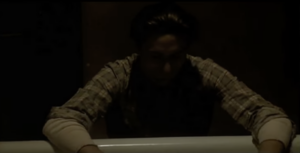
Michael closes the door on Kay again in Part 2, distraught over her revealing an abortion: “It was a son and I had it killed because this must all end! There would be no way you could ever forgive me. Not with this Sicilian thing that’s been going on for 2,000 years!” It’s twisted payback for a patriarchal society of men praying, “May it be a masculine child.”
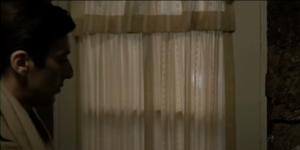
The final image is Michael sitting alone with his regrets as his half-lit face and cold stare give way to Rota’s iconic music. As we fade to black, the end credits reveal the true genius, the real puppetmaster pulling the strings: “Directed by Francis Ford Coppola.”
